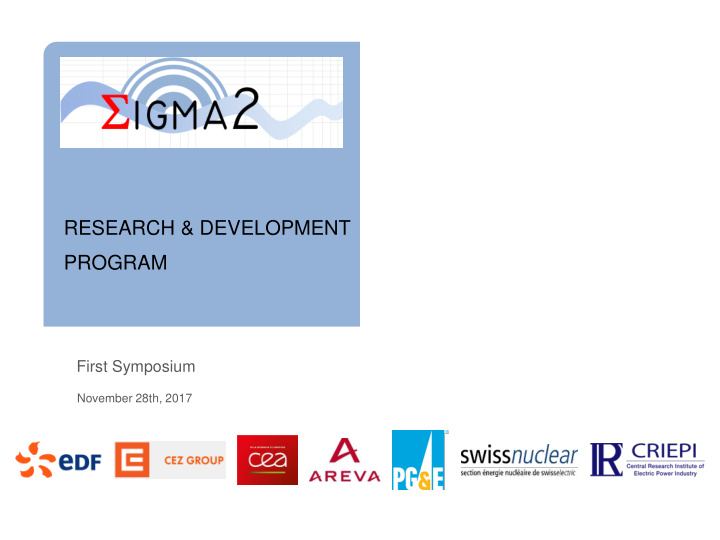



RESEARCH & DEVELOPMENT PROGRAM First Symposium November 28th, 2017
Reasons for a new project • Many R&D programs and actions have been performed in the field of SHA, • Nevertheless, the practice of seismic hazard assessment still suffers many uncertainties. • The funding partners of the project operate industrial facilities, including NPPs. In order to conduct industrial projects, it is necessary that natural hazards are estimated with a clear reliability, and be stable. first symposium - November 28th, 2017 2
Reasons for a new project • Still a lot of uncertainties, – Mmax • Still a lot of expert judgment in the SHA process – Weights of branches in logic trees • A need to stabilize some steps of the SHA process – GMPs for hard rock (Host to target adjustment ?) • A need to determine hazard levels more adapted to sites – Vs30 is only a proxy, not a parameter precisely predicting site response • A need to compare results of models to recorded data, for validation / verification of models first symposium - November 28th, 2017 3
Main Objectives • Make the estimation of hazard more robust and stable, • Make the definition of seismic ground motion directly usable by engineers, • Improve the representation of seismic motion, adapted to site conditions – reliable data, – validated models, – procedures to test both data and results • Deliverables – Internal reports – Scientific publications – Guidelines and recommendations – Databases – Softwares no direct hazard assessment for any site first symposium - November 28th, 2017 4
6 work packages PSHA • 1 – Faults & tectonics • 2 – Earthquake Parameters • 3 – ground Motion GM for faults & engineering • 4 – Site Response tectonics ground • 5 – PSHA motion • Earthquake 6 – Needs for engineering parameters first symposium - November 28th, 2017 5
Funding & industrial partners Total funding 8 M € • The funding partners (sponsors) of this project operate, manage and control industrial facilities, including nuclear installations – PG&E (USA) – CEZ (Czech Republic) – Swiss Nuclear (Switzerland) – CEA (France) – EDF (France) – AREVA (France) – CRIEPI (Japan) • EPRI (USA) is associated through a co-funding of actions included in WP3 performed by Berkeley Univ. • CNSC (Canadian Nuclear Safety Commission) will be associated through a co-funding of actions (on hard rock ground motion) that will be performed by University of Western Ontario first symposium - November 28th, 2017 6
Management of the project Scientific Teams Project Leader Steering Committee WP1 co-leaders WP2 co-leaders WP3 co-leaders Scientific Committee WP4 co-leaders WP5 co-leaders WP6 co-leaders first symposium - November 28th, 2017 7
People involved in project managment role name organization Project leader Christophe DUROUCHOUX EDF-CEIDRE Steering com (chairman) Pierre LABBE EDF Emmanuel VIALLET Steering Com Norm ABRAHAMSON PG&E Fabrice HOLLENDER CEA Jiri FUZER CEZ Philippe RENAULT Swiss Nuclear Yves GUEGAN AREVA WP leaders 1 Kevin MANCHUEL EDF-CEIDRE 1 Laurent BOLLINGER CEA 2 Emmanuelle NAYMAN EDF-CEIDRE 2 Jessie MAYOR EDF-LAB 3 Paola TRAVERSA EDF-CEIDRE 3 Luis DALGUER Swiss Nuclear 4 Cyril SIMON EDF-CEIDRE 4 Evelyne FOERSTER CEA 5 Irmela ZENTNER EDF-LAB 5 Norm ABRAHAMSON PG&E 6 Matthieu CAUDRON EDF-SEPTEN first symposium - November 28th, 2017 8 6 Gloria SENFAUTE EDF-LAB
Agenda of the symposium • 6 Work Packages : presentations of the reasons for the actions scheduled + discussions • 4 keynotes : state of the art, main questions – Fabrice Cotton hazard evaluation – Thierry Camelbeeck engine of seismicity – Norm Abrahamson GM for hard rock – Etienne Bertrand site response • Open discussions during lunch and pause first symposium - November 28th, 2017 9
THANK YOU
Recommend
More recommend